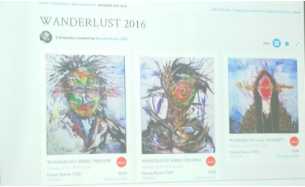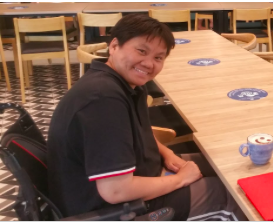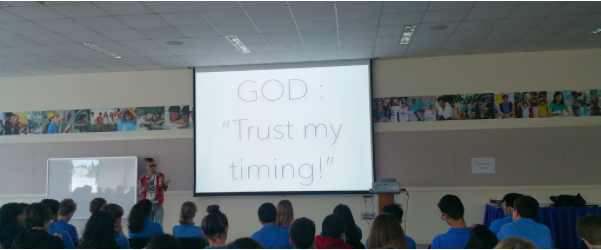Carry On
A Story of the Perseverance of the Ordinary
To the average member of society, every success story sounds so simple and straightforward. Yes, these people face obstacles, but it seems inevitable that they will reach the top. And it is that unstoppable obstinacy that makes their lifestyle appear so impossible. They seem to possess an insane amount of determination and are willing to exert effort to reach their goals. When students and adult employees rarely want to get out of their beds in the morning, how can they ever reach that level of productivity and resolve? The sheer magnitude of the obstacles modern heroes face look too difficult to overcome for the people living at the lower echelons of life.
Maybe the world of fame and the “normal” is just divided by pure destiny; either one is born with a mission and the opportunities to climb to the top or one is just fated for a mundane life.
But life is more unpredictable than that.
Danny Raven Tan and Christina Lau Lay Lian are two examples that giving up, despite how hard a situation seems, is not an option. Both of artists began their life as ordinary humans, indistinguishable individuals within the crowd, just trying to fight their way up the rungs of the social status ladder.

Like most young adults nowadays, Tan first started his path to the future studying a subject that would grant him a stable income but not a subject to his enthusiasm; in his case, he studied property development despite his interest in art. But he decided to take the initiative and push forward to make a future where his passion in art could thrive, overcoming the seemingly necessary need for a steady yet mundane occupation that society demands from its civilians.
During his journey to become a full-time artist, he faced numerous obstacles. He wrangled with cancer, mourned his father’s death, and discovered his mother’s dementia. Despite all the curveballs Life threw at him, Tan persevered. He could’ve just gave up on his dream and stayed down with the rest of the crowd, drifting from ordinary day to ordinary day, with no spark to light up his future. But he didn’t.
Through his determination, he has reached the life he wanted to create. He paints and sells his work in his flat in Ang Mo Kio; his subjects range from superheroes to a despairing comment on society’s lack of empathy to others. He even uses his own painful experiences as an opportunity to grow as both a human being and an artist, such as when he shot a photoshoot positioned around showing off the  scar he received from his cancer treatment, announcing a statement that all scars tell a story; in this respect, of victory.
scar he received from his cancer treatment, announcing a statement that all scars tell a story; in this respect, of victory.
“In life, we will face many challenges,” Tan says, “Just take the lessons and become stronger.”
Christina Lau originally started out as a prison officer. Her only ambitions then were about climbing to the top, like most others do. However, her entire life flipped around when she and her husband experienced a car accident in April 2005 that left Lau paralyzed; she suffers from a C-6 spinal injury, basically meaning movement below her chest is difficult. Once she heard that she may be unable to move properly or walk again, she fell into deep depression.
Similarly to Tan, she could’ve gave up at this distressing point in her life. And like Tan, she didn’t. She realised, with the help of the support and love given to her by family and friends, that she can’t let this accident force her down forever.
“Even if I fall down over and over again, I have to get up for the sake of my family,” Lau says.
In 2009, she joined a tetra activity in which she met others with similar disabilities as her. It was there that she learned mouth-painting. From there, she honed her skills and became a recognised student member of the MFPA (Mouth, Foot Painting Artists) in 2012. She eventually started to become as active like her previous self, albeit in a different method. She plays table tennis to exercise and keep herself healthy, and also for enjoyment.
“If you never try, you’ll never know how far you may go,” Lau says. “Life can be easy; Life can be difficult, but it all depends on how you look at it.”
Tan and Lau started ordinary enough, ambitious but not famous or immensely successful. Yet they managed to get to a place in their life where they are content and positive for what the future may bring, a small sweet taste of success. If they could rise despite the obstacles presented, then why can’t the rest of us? What most people seem to forget is that all celebrities, all the stars originally began somewhere with the rest of the public.
And no one knows what will happen, a fact Tan and Lau figure out from their experiences with cancer and physical disability, respectively. Today you may be safe, but tomorrow may bring something completely unexpected. Everyone has the power to reach their goals and dreams, and now is the time.
“If you don’t pursue your dream now,” Tan says, “then when? What do we leave when we die?”
Bibliography:
“CHRISTINA LAU LAY LIAN.” ActiveSG, Team Singapore, www.myactivesg.com/team-singapore/athletes/l/christina-lau-lay-lian.
“Christina Lau Lay Lian.” MFPA, MFPA, mfpa.com.sg/artists/christina-lau-lay-lian/.
“Danny Raven Tan.” The Artling, The Artling, theartling.com/en/artists/danny-raven-tan/.
Fang, Joy. “S’pore Artist Danny Raven Tan Showcases His Works in Flat.” TODAYonline, TODAYonline, 10 Feb. 2016, www.todayonline.com/entertainment/arts/spore-artist-danny-raven-tan-showcases-his-works-flat.
Miyano, Sakura. “Why Christina Lau Paints.” Site Title, 8 Feb. 2017, priorities.school.blog/2017/02/08/why-christina-lau-paints/.

